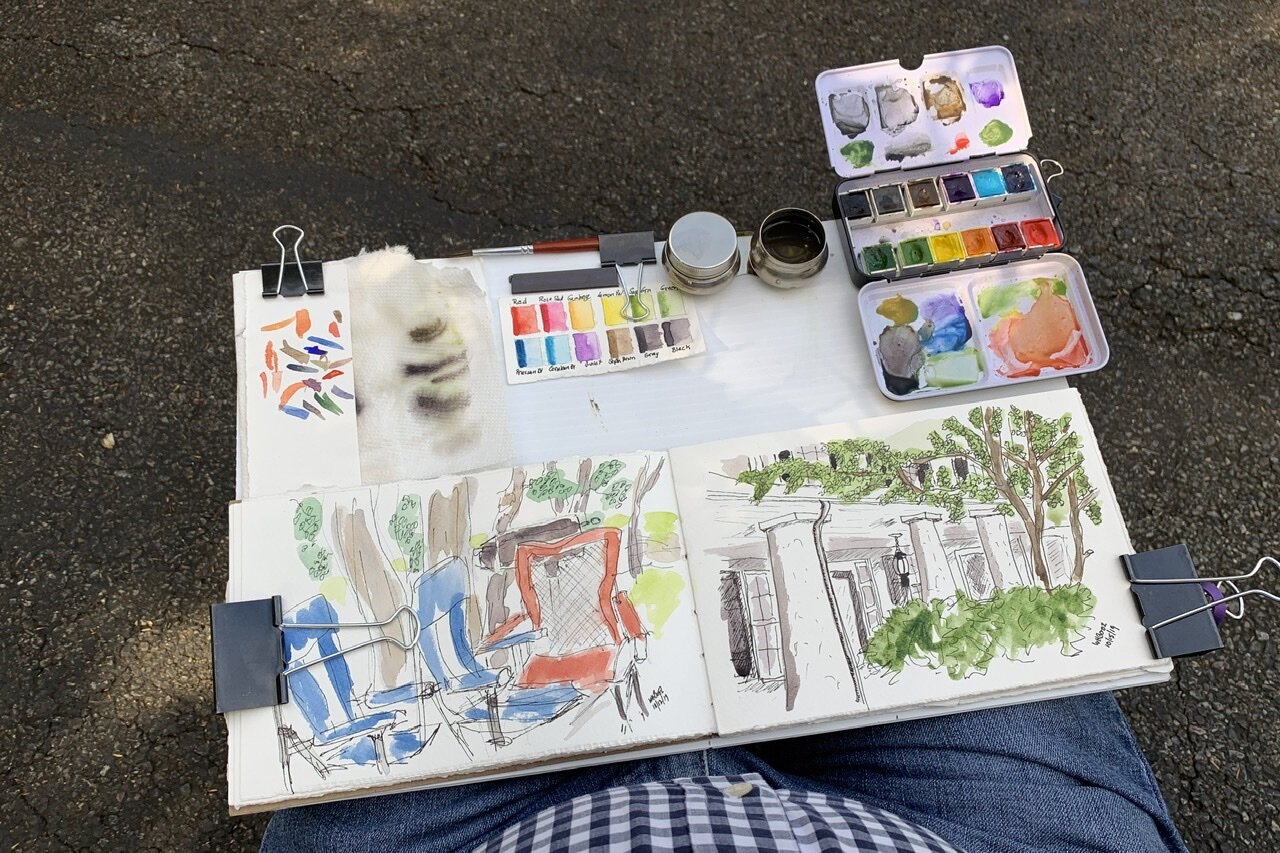What Tools Does One Need for On-Location Sketching?
The essential tools needed to do on-location sketching are quite minimal. It could be one of the least expensive hobbies you every take up! That is, until you start to get really hooked and decide to expand your toolset. However, even then it’s not as expensive as other pursuits such as golf, skiing, tennis, or photography. So, what do you need? Honestly? Just a regular pencil with an eraser and paper. Maybe a pad of paper. And a hard surface to draw on. That’s why a paper pad or sketchbook is handy. That’s really it! If you want to step it up a notch, you might decide to get a nice mechanical pencil with .05 or .07 HB lead. Might be nice, too, to get a sketchbook with “proper” sketching or drawing paper. In the hierarchy of paper, with newsprint and printer paper at the bottom, “drawing” paper” is a bit better (read: heavier/thicker) than “sketching” paper. Check a store like Michael’s or Hobby Lobby and look at the type of paper in the sketchbooks on display. They will have either “sketch” or “drawing” on their covers.
Those are the only tools you need to start sketching things you see around you. However, if you want to add ink and watercolor to your sketches, as most on-location sketchers do, then you’ll need a few more things. And you’ll want to go a notch higher with your paper selection. Assuming that you do want to add ink to your sketches and then watercolor paint, you’ll want to buy a pad or sketchbook with “watercolor” grade paper or “mixed media” paper. These papers are created to be able to take the addition of wet media such as watercolor paint mixed with water. They are thicker and heavier than “drawing” paper and, therefore, won’t buckle or get all rippley and funky when the paint dries. Personally, I prefer watercolor paper rated at 140lb/300 g/m². Compare that to the paper in a pad of “drawing” paper rated at something like 60lb/110 g/m². The second part of this paper weight designation is simply the metric weight, grams per square meter. Another designation for these papers is whether the paper is “hot press” or “cold press.” This refers to how the paper was processed. Cold press paper has a texture, whereas hot press paper is smoother. Some like hot press (smooth) paper if they’re working with ink. However, I use ink and prefer cold press paper as I like the appearance of my final inked paintings on textured, watercolor paper.
Typical 12-pan watercolor palette with mixing areas and a small brush.
Continuing with what you need if you want to ink and add watercolor to your sketches, you will want an ink pen. For starting out, I recommend a simple, fine-tip, permanent black ink pen. The simplest one is a fine point Sharpie, but there are many very good fine-tip ink pens to choose from. My favorite is the Sakura Micron line. For details I like a 01 tip and for general use an 05 tip. As far as watercolor choices go, there are tons of options, but if you are just seeing if sketching and watercolor painting is for you, I would recommend buying an inexpensive kit (“palette”) from Michael’s or Hobby Lobby. Such a kit will probably have 12 colors and one or two brushes and you’ll be ready to go. However, if you already know this is something you want to pursue then you will want to get a nicer palette already filled with quality paints from manufacturers such as Daniel Smith or Winsor & Newton. Another option is to purchase a nice, small, empty travel palette and tubes of quality watercolor paint (same manufacturers). Naturally, you will need a brush, though one or more may come with your palette. Brushes are numbered. As an all-purpose brush, I would recommend a #6 Round. Next, you will need a small container for water and some paper towels or a reusable rag to wipe your brush on. For water a small, plastic cup will work though many on-location sketchers use collapsible cups. Finally, you will need a bag in which to carry these things. As you will often move from one place to another, you want both the bag you use and the gear you carry to be as light and compact as possible.
Now you are equipped to hit the streets and start doing some on-location sketching and, if you want to and have expanded your kit, painting!





